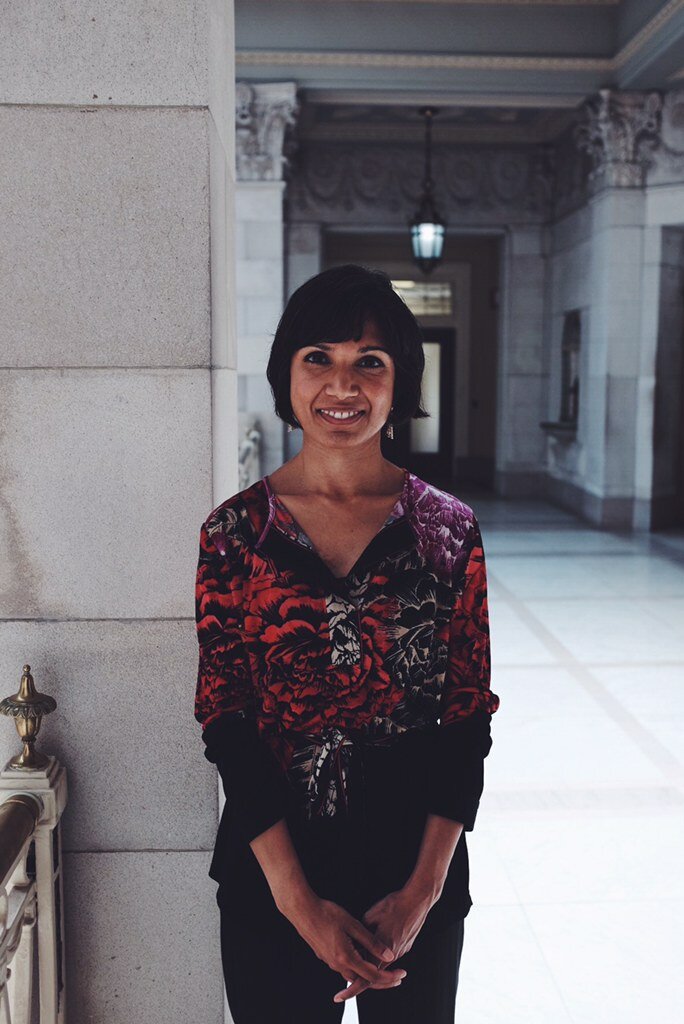Shubhada Kambli
A little over a year ago the City of Hartford created the Office of Sustainability to help city get to where it needs to be. Recently this led to the creation of the Climate Action Plan to help provide the framework and goals for all stakeholders in the city to be a more resilient community. We sat down with Shubhada Kambli to learn more.
Thank you for making time today. I think through the creation of this plan, and some and on the subject of sustainability, there has been a ton of community involvement and input, which is really amazing. But, Hartford in a wider context probably does not know a lot about what's going on here. Could you give us a quick background for all of this, for this office and this plan.
Sure. We have seen in the city, across the country, around the world, the fact that our weather is getting more and more severe. Locally, we know that we have warmer, wetter winters, droughts, and extreme storms. The climate action plan is an effort to improve the resiliency of our community, and protect our residents as well.
Can you give us a little bit of insight about where we are right now, and how the office itself came about.
The Climate Action Plan addresses goals and strategies across six different areas of sustainability, including energy, food, landscape, waste, water, and transportation. The idea is to really be able to ensure that our community is climate resilient, and using some of our environmental work to make Hartford cleaner, greener, and healthier.
That’s awesome. It feels fairly relevant considering all the things going on, whether it's Texas, Puerto Rico, or Florida. It’s a fascinating time to have that context surround our conversation. So taking a step back, you head up this office which is called officially…
The Office of Sustainability within the Office of the Mayor.
Fantastic. Why don’t you tell us a little about yourself, and how you ended up here?
I have worked in local, state, and federal government in jobs related to energy efficiency and neighborhood revitalization. I feel like a lot of the work I have done really comes together in this role. I’ve worked as an environmental engineer for the US EPA in the Boston regional office, leading programs related to municipal energy efficiency. So, how do we ensure that buildings across the region are being benchmarked, or evaluating energy consumption? And then ultimately reducing that consumption to in order to be better environmental stewards, and fiscal stewards of taxpayer dollars as well. I have worked, in addition to New England, in South Bend, Indiana, in a vacant and abandoned property initiative called “A Thousand Houses in A Thousand Days.” I was very lucky to work with a fantastic team that was able to address some really systemic issues in a meaningful way. So, I am bringing some of those experiences back to my home state of Connecticut.
Oh, so you’re from here?
Yes, Hartford county, that’s right.
Awesome. So Hartford, Connecticut isn’t new to you.
I’m a Connecticut native, yea. I’ve had family in this area for about 15 years.
Well, welcome back if it’s not too late to say that. We're happy to have you back, we're happy to have this initiative going on. I had the chance to read over the Climate Action Plan draft a couple weeks ago. I think you guys finalized that draft in the meantime, is that right?
We did, the Climate Stewardship Council approved that draft a few weeks ago, and the Planning and Zoning Commission also endorsed it as well.
Awesome, that’s super exciting. Diving into the plan itself, after reading through it, it was clear to me that there was a ton there and a ton of opportunities there. My question is, how did it come together and how did it come to be?
There were a number of people who worked on this plan in advance to the formation of the Office of Sustainability. The 34 member Climate Stewardship Council, led by Sara Bronin, drafted the Climate Action Plan. There were more than 10 interns from UCONN Law School who also participated, and more than 200 stakeholders who were reviewing the plan itself. It was an enormous effort, and sort of one that took some time and energy in order to complete.
The plan sort of speaks for itself in that. From the outside looking in, it seems like a fairly comprehensive plan to put Hartford in a much better place environmentally. If we were to execute all the things laid out in the plan, where do you think Hartford would be in terms of creating greater resiliency in the community?
I would say that there are already a number of successes in the city to be proud of that are highlighted in the plan itself. There are a number of organizations that have done extensive amounts of work around the environment and sustainability. If you look on the energy side, for example, the city has recently won a $5 million street light grant, to upgrade or retrofit our lights to make them more energy efficient, and make our neighborhoods brighter and safer. We also have a fuel cell microgrid at the Parkville Community School. That’s a fuel cell that on a daily basis powers a number of different buildings, but in the time of a power outage, it has the ability to feed power to the C-Town grocery store and Shell gas station there to make the community a little bit more resilient, and provide some critical needs to residents.
So, it’s set up so that in case of power failure, there would be a resilient city block for the community to rely on?
That’s right. That was a project that was supported by Connecticut DEEP, who provided us with a $2 million grant. So, we’ve been really well supported by the state and other agencies in order to complete some of the work to date. What we see in the plan are goals and strategies that build upon a really strong foundation.
That’s awesome. So while the plan seems very comprehensive, it also seems like its calling for a massive undertaking. My interpretation of the plan is that while there are big things that the municipality and state can do, there’s a lot that needs to happen on a residential level and on a business level. We live in that space more often, and it seems to me that there needs to be a lot of culture change that would need to happen. There would need to be a lot of opportunities created for this plan to really come to life. That might be the biggest challenge of the whole thing. I was wondering where you guys are looking to get started in terms of tackling that.
We want to make sure that we are creating opportunities for businesses and residents to be engaged in this work. There are existing opportunities through some of the boards, commissions, and NRZ groups in town. We are looking to create some targeted discussion groups around each of the areas of sustainability that are outlined here. So, that I would say is one of the key opportunities that has come out of this process. The schedule for those discussion groups will be posted on the Climate Stewardship Council website, so that’s something that people who are interested in working in these areas can look out for.
In some ways, you kind of have a plan, you have a lot of input and stakeholders involved, and now you are trying to take this forward as a movement. Is that fair to say? You’re really trying to push it forward in a robust way.
That’s right. There are different elements of the plan, some are largely community focused and driven, and there are some elements that have to do with city operations. For example, reducing energy consumption in our operations, or improving the use of renewables.
I think a lot of people would get excited about the plan overall, particularly because it has a clear vision for what it wants. The ways it wants to get there, I believe you label as three different things...
Yes, economic development, public health, and social equity.
That, to us, really brought us on board. It seems to be a play you could actually make, something you could actually do. Doesn’t necessarily make it easy, but you can get a lot of different stakeholders involved, whether community, businesses, municipalities, or whatnot. It looks like a nice meshing. How do you see social equity and economic development working together to make some of the goals happen? How do you see businesses coming to the table to solve part of the plan?
I would say that green jobs are a key way that equity and environmental conservation can come together. We’re looking at ways to support green jobs training programs that would allow for our youth, and older individuals as well, to get the job skills training that they need in order to meaningfully participate in a green economy.
There’s an organization in Cleveland that we’ve been inspired by called the Evergreen Cooperative. One of the things that they did is create a bunch of worker owned cooperatives. I believe one of the business cooperatives trained folks to be solar panel installers, essentially. They were the people that made the solar panel installations happen. They were able to create a lot of equity through it because the company that was responsible for doing it was owned by the people themselves. That could be a way to do that, but it also means that a whole bunch of other work had gone on through the organization itself to create the opportunities and do the training.
The climate action plan actually highlights some success stories, that are similar to that. We have individuals who have gone through energy efficiency training programs who have gone through energy efficiency training programs at Capital Community College. They ended up being able to do weatherization work for local small businesses. That’s the kind of work that we want to support and be able to grow ultimately.
Some of the pieces in the draft plan intersect with our work got me excited. Whether it’s us being adjacent to the Park River, and wanting to see that become a resource as opposed to what it is now, or the discussion of reinvigorating parts of the regional market. Those are the things that we get really excited about and as a business, would love to figure out how to be a part of and how to invest in. How do you see some of those bigger scale projects kicking off? Do you see that as being something that has to happen behind the scenes, or do you see the community driving that themselves?
I think it’s a combination of both. In terms of some of the water quality and green infrastructure work, we are funded through a UCONN initiative to support staff members who are completely focused on stormwater management and water quality through more natural measures. I would say that some of those projects, like the Park River cleanup and maintenance, would require having a larger scale effort with people around the table ranging from MDC, to the City, DPW, as well as other individuals who have been active around these issues.
Yea, for sure. I drive over the Park River on Hamilton all the time. For me, I always have this desire, especially after the hot summer we just had, to jump in the water and cool down. There not being a freshwater watering hole in the city, I get super excited about the potential for there to be one right around the corner from me. I don’t know if that will ever be a reality, but that would be something that I would be very excited about helping to galvanize.
Yes, I completely agree. We’ve definitely seen some significant improvements in water quality in this area. The Connecticut River, for example, was the nation’s first Blue Way, designated in 2012, and it is swimmable and fishable.
I spent a fair amount of time when I was younger in New Hampshire. Up there, you can swim in the Connecticut River no problem. It’s much slower moving, and it’s closer to the mountains so the water is fresher. It’s lovely up there, and then 2 hours down I-91, it’s a different mentality. I find that potentially exciting, but at the moment a little bit discouraging. The switch might come at some point, I think there’s a lot of exciting things happening, like the discussion about the bike path along the river up through Windsor.
There has been some great work by organizations like Riverfront Recapture, and other efforts to increase accessibility to the river and other bodies of water.
I continue to think that we do a lot of great work getting people to the banks of the river, but I think if we can figure out a way to actually get people in the river, whether it's on boats or actually swimming in the river, that’s when we’ll see a culture shift. When that sort of barrier is broken, the realization of it as a resource will come to be.
Like the dragon boat racing.
Right, I think that makes a difference. At the end of the day, just getting people on the water, whether it’s canoeing, kayaking, dragon boats, or power boats, as long as they’re on the water, I think it will make a big difference. If you ever want to do a giant kayak race, let us know.
That’s awesome, yea.
So, you gave us some hints about what’s coming as far as creating some of these working groups. What else do we have to look forward to?
I would say that that is one of the keys to making sure that we have enough community engagement in order to build some momentum around the Climate Action Plan implementation. We’ve been working really hard and diligently to make sure that our operations are in order, especially as it relates to energy. Our work around existing energy projects has really been extensive and high impact.
If the plan is any indication of the rest of your work, we are very excited in general. We work on Bartholomew Ave, so we’re aware of the stormwater/streetscape change that looks like it is going to get started next year. Is there a need to do a lot more of those projects in Hartford? Is that need greater than the community might realize at this moment for that infrastructure level work?
We’re looking at ways to test the efficacy and the impact of green infrastructure installations, and working with MDC, DPW, and other organizations to understand the elements of green infrastructure and how they might be applied to different areas of the city. That is absolutely something that is on the table right now.
Awesome. Well we are very excited to see what will come. Thank you very much for your time.
Thank you. I appreciate it.
Photography by BLK FRM VSN








